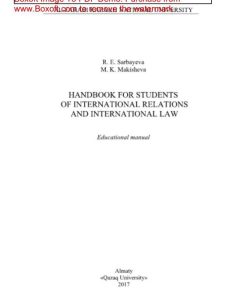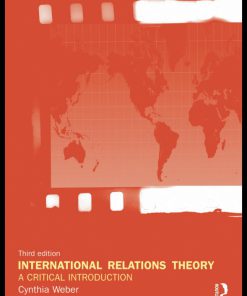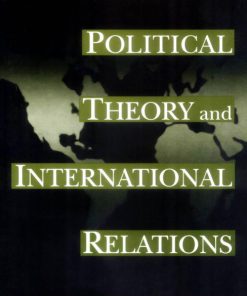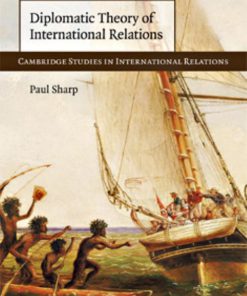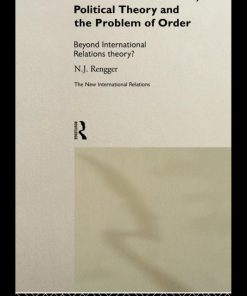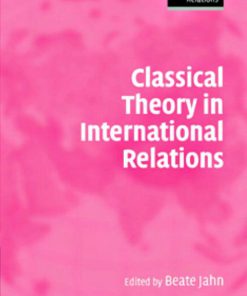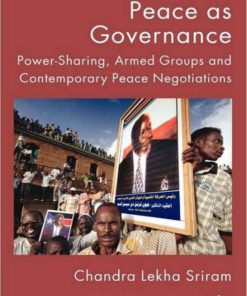International Law and International Relations Bridging Theory and Practice 1st Edition By Thomas Biersteker, Peter Spiro, Chandra Lekha Sriram, Veronica Raffo 0415459591 9780415459594
$50.00 Original price was: $50.00.$25.00Current price is: $25.00.
Authors:Thomas J. Biersteker et al.; (Edt.) , Series:International Relation [38] , Author sort:al., Thomas J. Biersteker et & (Edt.) , Languages:Languages:eng , Published:Published:Oct 2006 , Publisher:Routledge
International Law and International Relations Bridging Theory and Practice 1st Edition By Thomas Biersteker, Peter Spiro, Chandra Lekha Sriram, Veronica Raffo – Ebook PDF Instant Download/Delivery. 0415459591, 9780415459594
Full download International Law and International Relations Bridging Theory and Practice 1st Edition after payment
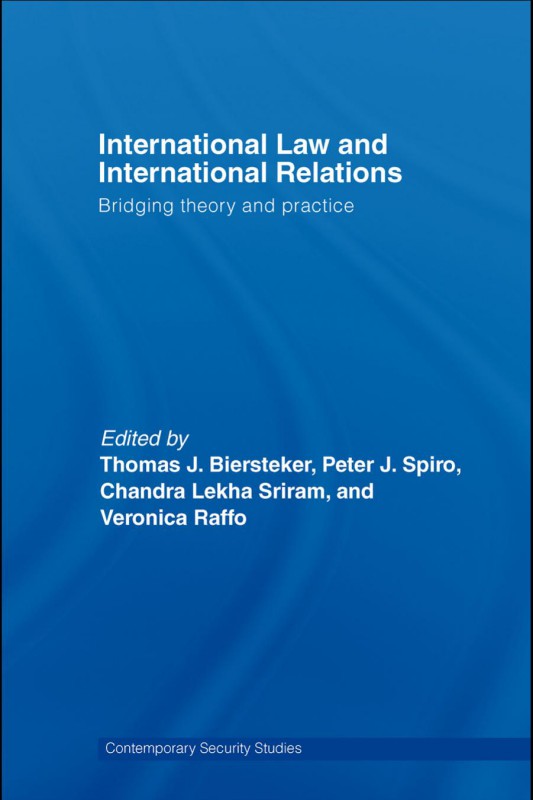
Product details:
ISBN 10: 0415459591
ISBN 13: 9780415459594
Author: Thomas J. Biersteker, Peter J. Spiro, Chandra Lekha Sriram, Veronica I. Raffo
This unique volume examines the opportunities for, and initiates work in, interdisciplinary research between the fields of international law and international relations; disciplines that have engaged little with one another since the Second World War. Written by leading experts in the fields of international law and international relations, it argues that such interdisciplinary research is central to the creation of a knowledge base among IR scholars and lawyers for the effective analysis and governance of macro and micro phenomena. International law is at the heart of international relations, but due to challenges of codification and enforceability, its apparent impact has been predominantly limited to commercial and civil arrangements. International lawyers have been saying for years that ‘law matters’ in international affairs and now current events are proving them right. International Law and International Relations makes a powerful contribution to the theory and practice of global security by initiating a research agenda, building an empirical base and offering a multidisciplinary approach that provides concrete answers to real-world problems of governance. This book will be of great interest to all students of international law, international relations and governance.
International Law and International Relations Bridging Theory and Practice 1st Table of contents:
1 Introduction International law and international politics — old divides, new developments
Introduction: law and politics after the Cold War
Genesis of the project
International law and international relations: defining the gap, bridging the gap
International law, international relations, policy practitioners, and the state
Organization of the volume
Small arms and light weapons
Terrorism
Internally displaced persons
International criminal accountability
Key conclusions
Insights from the volume: new perspectives on old divides
The state
Sources of legitimacy and authority
Norm development
Practitioners and academics
Conclusion: moving the debate forward
Notes
Part I Small Arms and Light Weapons
2 Moving Forward? Assessing normative and legal progress in dealing with small arms
Introduction
The evolution of the small arms discourse
Considering the supply, effects, and demand for small arms
Development of norms and regulations to control supply
Effects and demand-side normative development
Conclusion
Notes
3 Small Arms, Violence, and the Course of Conflicts
Introduction
Local social structures and violent conflict
Coercion, violence, and collapsing states
Coercion, greed, and public goods
Dealing with complexity
Conclusion: implications for small arms regulation and the international relations—international law discourse
Notes
4 Commentary: a World Drowning in Guns
Introduction
The problem
The approach
Thinking about a solution
Norms and horizontal process
Vertical process: internalization
Conclusion
Acknowledgments
Notes
Part II Terrorism
5 International Terrorism, Nonstate Actors, and Transnational Political Mobilization A perspective from International Relations
International terrorism as a conceptual challenge for international relations
Nonstate actors, political violence, and international security
International relations theory and violent nonstate actors
A political mobilization perspective on violent nonstate actors
Conclusion: implications of a political mobilization perspective
Notes
6 Crying War
Introduction
The violations
The false claim of war
False claims of privilege
The motivations
The consequences
Conclusion
Acknowledgments
Notes
7 Preemption and Exception International law and the revolutionary power
Introduction
The dual agenda revisited
The Bush Doctrine: responding to the new threat from the coupling of global terrorism and WMD
Legitimating preventive war: unilateral and collective responses
America as the exceptional hegemon
Conclusion
Acknowledgments
Notes
8 Commentary: Convergence of International law and International Relations in Combating International Terrorism The role of the United Nations
Introduction
An increasingly active Council after the Cold War
The Security Council and terrorism before September 11, 2001
The Security Council and terrorism After September 11, 2001
Unilateral responses to terrorism and realist international relations theory
Combating violent nonstate actors
Compounded failings: unilateralism and nonstate actors
Conclusion: the promise of liberal responses
Notes
Part III Internally Displaced People
9 The Guiding Principles on International Displacement and the Development of International Norms
Introduction
Conceptual issues
Definition and provenance of norms
The function of norms
Compliance with norms
Development of the Guiding Principles on Internal Displacement
Genesis of the Guiding Principles
Development of a normative framework
Reception and application of the Guiding Principles
The Guiding Principles as international norms
The Guiding Principles and international norm building
The Guiding Principles and the effectiveness of norms
What the theory suggests about next steps
Conclusion
Acknowledgments
Notes
10 Commentary: Privately Generated Soft Law in International Governance
Introduction
Privately generated soft law
Creating privately generated soft law
Disseminating and adopting privately generated soft law
Notes
Part IV International Criminal Accountability
11 The International Criminal Court and Universal International Jurisdiction A return to first principles
Introduction
Negotiation of the ICC’s jurisdiction prior to and during the Rome diplomatic conference
A theoretical assessment of the Court’s jurisdictional principles
The notion ofjus cogens crimes
The exercise of universal (international) jurisdiction by the Rome Statute for the International Criminal Court over the jus cogens crimes embodied in the statute
The need for comity, complementarity, and balance in the exercise of international criminal adjudication
Notes
12 International Humanitarian Law State collusion and the conundrum of jurisdiction
Introduction
On the problem of perpetrator regimes
Immunities
Universal jurisdiction
International tribunals
Conclusion
Notes
13 Whose Justice? Reconciling Universal Jurisdiction with Democratic Principles
Introduction
Transnational lawmaking processes
Should transnational lawmaking processes be democratic?
Pinochet as paradigm: judge-made law across borders
Judicial lawmaking in national proceedings
Judicial lawmaking in a transnational setting
Assessing the democratic legitimacy of transnational adjudication
Universal jurisdiction and emergent democracies
Upending democratic deliberations?
Do transnational processes undermine democratic deliberations? a challenge
Acknowledgments
Notes
14 Bringing Security Back In International relations theory and moving beyond the”justice versus peace” dilemma in transitional societies
Introduction: peace, justice, and international relations theory
The problem of postconflict justice
International relations theory and postconflict justice
Constructivism
Liberalism
Realism
Bringing security back in: (re)constructing stability and the rule of law
Security and justice: lessons from Sierra Leone
Dispute over the validity of the Lomé amnesty
Dispute regarding head-of-state immunity and the legality of the Special Court agreement
The Special Court and former combatants
Timing and security: did the Special Court begin work too early?
Relation to other accountability efforts
After UNAMSIL: prospects for peace, security, and justice
Policy implications
Conclusion
Acknowledgments
Notes
15 Commentary: International Criminal Accountability at the Intersection of Law and Politics
Notes
Part V Conclusions
16 Disaggregating us Interests in International Law Sketching a theory of liberal transnationalism
Introduction
Bringing international relations theory home
The exceptional case of the United States
New causal pathways for international law
Transnational pressure points
Nonstate norm regimes
Disaggregate and conquer
Subnational actors
Congress
Executive branch agencies
The judiciary
Conclusion
Notes
17 New Directions, New Collaborations for International Law and International Relations
Introduction
Grounds for collaboration: shared interests and where they might lead
Dynamics of law and politics
Beyond formalism and structure: the importance of social context
Unpacking assumptions: nonstate actors and national capabilities
Conclusion
Notes
18 International Relations and International Law From competition to complementarity
“And ne’er the twain shall meet”
A subjective view of the international relations—international law divide
International relations and international law: two cases of constructive engagement?
Small arms
International terrorism
Bridging the international relations–international law divide to confront current challenges and crises
Notes
Selected Bibliography
Books
Articles, chapters, and papers
Treaties, United Nations documents, cases, and other legal materials
People also search for International Law and International Relations Bridging Theory and Practice 1st:
9 international
4 international crimes
0-1 law
z international inc
z international
You may also like…
eBook PDF
Political Theory and International Relations 1st edition by Charles Beitz 9781400822928 1400822920
eBook PDF
Diplomatic Theory of International Relations 1st Edition by Paul Sharp 0521760267 9780521760263
eBook PDF
Classical Theory in International Relations 1st Edition by Beate Jahn 0521686024 978-0521686020



